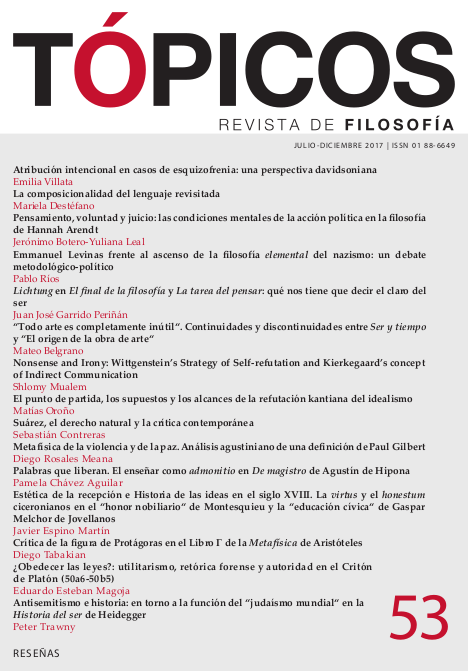“Todo arte es completamente inútil”. Continuidades y discontinuidades entre Ser y tiempo y “El origen de la obra de arte”
Publicado 2017-07-01
Palavras-chave
- obra,
- útil,
- Dasein,
- arte
Como Citar
Resumo
Este trabajo se propone analizar el papel del útil (Zeug) y su diferencia con la obra de arte en “El origen de la obra de arte” a la luz de lo desarrollado en Ser y tiempo. Mientras que “lo a la mano” se constituye por su estructura remisional que inaugura del Dasein, el arte “abre mundo”, es decir, abre una nueva red de significados, independientemente del sentido que le quiso dar el artista. Que el arte “muestra el ser del útil” no quiere decir que meramente muestra “la esencia de una bota”, sino la estructura remisional de “lo a mano”. El cuadro de las botas de Van Gogh funcionará como ejemplo para mostrar las diferencias entre la obra y el útil. A la luz de esta interpretación, analizaremos las críticas de Schapiro y Schaeffer a la lectura heideggeriana del cuadro del pintor holandés.
Referências
- Heidegger, M. (2013). Kant y el problema de la metafísica. Roth, G. I. (trad.) México: Fondo de Cultura Económica.
- ____ (2012a). El origen de la obra de arte (1935/36). En Caminos de Bosque. Madrid: Alianza Editorial, S. A.
- ____ (2012b). Ser y tiempo. Madrid: Trotta.
- Bibliografía secundaria
- Bareiro, J. y Bertorello, A. (2011). Ontología de las relaciones objetales en Winnicott: Útil, obra de arte y cosas. En III Congreso Internacional de Investigación y Práctica Profesional en Psicología XVIII Jornadas de Investigación Séptimo Encuentro de Investigadores en Psicología del MERCOSUR. Buenos Aires: Facultad de Psicología - Universidad de Buenos Aires.
- Bertorello, A. (2008). El límite del lenguaje. La filosofía de Heidegger como teoría de la enunciación. Buenos Aires: Biblos.
- ____ (2006). La polémica en torno a la estética ontológica de Heidegger: Schapiro, Schaeffer y Derrida. En Constrastes. Revista Internacional de Filosofía, XI, 65-82.
- Derrida, J. (2010). La verdad en pintura. Buenos Aires: Paidós.
- Domínguez, J. (1991). La teoría estética en Heidegger. En Areté: Revista de filosofía, III, 2, 183-205.
- Dreyfus, H. L. (2003). Ser-en-el-Mundo. Comentario a la División I de Ser y Tiempo de Martin Heidegger. Huneeus, F. y Orrego, H. (trads.)
- Santiago de Chile: Editorial Cuatro Vientos.
- Harries, K. (2009). Art matters. A Critical Commentary on Heidegger ́s “TheOrigin of the Work of Art”. Dordrecht: Springer.
- Lafont, C. (1997). Lenguaje y apertura del mundo. El giro lingüístico de la hermenéutica de Heidegger. Madrid: Editorial Alianza.
- Schaeffer, J. (1990). La imagen precaria. Del dispositivo fotográfico. Jiménez, D. (trad.) Madrid: Ediciones Cátedra.
- Schapiro, M. (1999). Unas cuantas notas más sobre Heidegger y Van Gogh. En Schapiro, M. Estilo, artista y sociedad. Teoría y filosofía del arte. Madrid: Tecnos.
- ____ (1999). La naturaleza muerta como objeto personal: unas notas sobre Heidegger y Van Gogh. En Schapiro, M. Estilo, artista y sociedad. Teoría y filosofía del arte. Madrid: Tecnos.
- Sheehan, T. (2015). Making sense of Heidegger: a paradigm shift. London: Rowman & Littlefield.
- Vattimo, G. (2006). Introducción a Heidegger. Barcelona: Gedisa.
- ____ (1993) Poesía y ontología. Valencia: Universitat de València.
- Vigo, A. (2008). Arqueología y aleteiología. Buenos Aires: Biblos.






